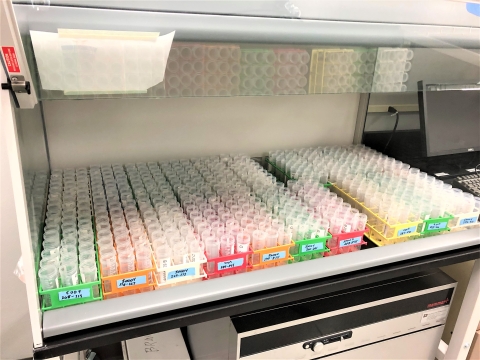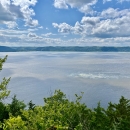About Us
The potential invasion of carp species is the biggest threat facing the Great Lakes and other U.S. waters today. Four species of non-native carps: the highly invasive bighead and silver carp, and the potentially damaging black and grass carp are concerning to resource managers. State, local and federal agencies are using the best science and technologies available to prevent these carp species from degrading sensitive waters in the United States.
The Whitney Genetics Lab was established in 2013 and is supported by the Great Lakes Restoration Initiative and base U.S. Fish and Wildlife Service funding. The lab uses environmental DNA, also known as eDNA, testing for early detection of invasive carp in the Chicago Area Waterway System, the Illinois, Upper Mississippi and Ohio rivers and tributaries of all five Great Lakes. The lab has the capacity to process about 8,000 eDNA field samples each year, and several thousand more for research to improve and test new methods.
In addition to invasive carp eDNA monitoring, we provide species identification via genetic sequencing for wild caught fish, eggs and larvae that are captured as part of traditional fisheries work in invasive carp monitoring programs. We also provide genetic data for monitoring and conservation programs for U.S. Fish and Wildlife Service priority threatened and endangered species. Lab staff participate in development of new scientific methods to help meet the management goals of the Service and its partners.
Our Mission
“Working in partnership, we provide leadership in science, technology and education for conservation of aquatic ecosystems emphasizing fisheries, aquatic invasive species invasive species
An invasive species is any plant or animal that has spread or been introduced into a new area where they are, or could, cause harm to the environment, economy, or human, animal, or plant health. Their unwelcome presence can destroy ecosystems and cost millions of dollars.
Learn more about invasive species , genetics and aquatic animal health for the benefit of the public”.
Our History
1995 - The La Crosse Fish Health Center and the La Crosse Fish and Wildlife Conservation Office, along with the offices for the Upper Mississippi River National Wildlife and Fish Refuge - La Crosse District, moved to its current location in Onalaska, Wisconsin.
2013 - The Midwest Fisheries Center was established, housing the Whitney Genetics Lab within the La Crosse Fish Health Center along with housing the La Crosse Fish and Wildlife Conservation Office and the Regional Watercraft Safety Coordinator.
2015 - The first Midwest Fisheries Center Director was hired in addition to core administrative and GIS staff.
2018 - The Midwest Fisheries Center lobby was renovated to add more workspace as well as visitor information and displays.
Other Facilities in this Complex
The Midwest Fisheries Center houses the La Crosse Fish Health Center, La Crosse Fish and Wildlife Conservation Office, Whitney Genetics Lab and administrative, GIS and outreach staff, as well as the Regional Watercraft Safety Coordinator.




